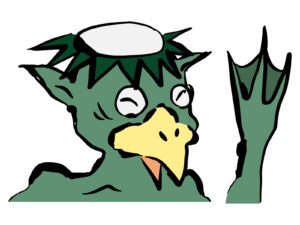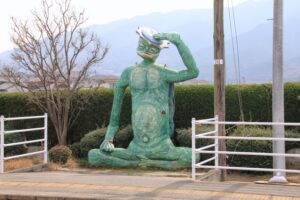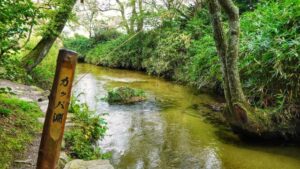Japan is home to countless yokai legends, many of which are still passed down to this day. Among them, few are as widely known or as deeply embedded in the collective imagination as the kappa.
A creature of the water, the kappa has been depicted both as a mischievous yet endearing figure and as a fearsome being capable of harm. With its distinctive features and the wealth of stories surrounding it, the kappa remains one of the most intriguing and enigmatic figures in Japanese folklore.
What Is a Kappa?

Green skin, a small shell, and a plate on its head—the image of a kappa.
Green skin, a small turtle-like shell, and a water-filled dish on its head—when we envision a kappa, it might seem almost comical, even familiar.
Yet, delve into the old tales, and a more sinister side emerges.
Some legends tell of kappas dragging children into the water, while others speak of them engaging in sumo wrestling matches with humans or even repaying kindness in unexpected ways.
These diverse stories suggest that the kappa is not merely a mythical creature but a being intertwined with the daily lives and beliefs of the Japanese people.
But is the kappa nothing more than a product of imagination?
Or could there be something more, something hidden beneath the surface?
Despite the passage of time, the image of the kappa remains vivid and unchanged. Its stories continue to be told across generations, adapting to the shifting cultural landscape while maintaining their mysterious allure.
Regional Variations of the Kappa Legend
The kappa’s nature varies depending on the region and the era.
In some areas, the kappa is feared as a malevolent creature that lures children to a watery fate. In others, it is portrayed as a friendly, almost comical yokai that interacts with humans in surprising ways.
One common thread throughout these tales, however, is the kappa’s deep connection to humans.
For instance, some legends describe kappa engaging in sumo wrestling with people, while others tell of villagers offering cucumbers to appease them and protect their rice fields from mischief.
Today, the kappa has become one of the most beloved figures in Japan’s yokai folklore. Many towns hold festivals in its honor, and some have even turned kappa legends into local attractions.
In Kurume City, Fukuoka Prefecture, kappa statues and murals line the streets, preserving its lore.

The Kappa Statue at Tanushimaru Station in Kurume City.
Meanwhile, in Tono City, Iwate Prefecture, the infamous “Kappa-buchi” (Kappa Pool) continues to attract visitors with its legend of cucumber baiting, offering a glimpse into the world of these elusive creatures.

Kappa-Buchi: The Legendary Kappa Pool of Tono, Iwate Prefecture
Do Kappa Really Exist?
Are kappas purely the stuff of legend, or could they be based on real creatures? This question has fascinated people for centuries and remains the subject of speculation even today.
During the Edo period (1603–1868), supposed kappa mummies were enshrined in temples or displayed in traveling sideshows.
One notable example is the preserved kappa hand once kept in San’gidō, a medical institution in old Tokyo.。
Even now, relics identified as kappa mummies exist in various locations, such as Honkoji Temple in Okayama Prefecture and Jokenji Temple in Iwate Prefecture.
Scientific analysis suggests these artifacts might be crafted from animals like monkeys or rays, yet their true nature remains unresolved.
Beyond relics, eyewitness accounts of kappas have been recorded throughout Japan.
Particularly in the Showa era (1926–1989), numerous reports described small, human-like creatures disappearing into rivers. In the 1950s, sightings were documented in Fukuoka and Yamagata Prefectures, fueling further speculation.
Theories on the Kappa’s True Identity
Over the years, various theories have emerged attempting to explain what kappas might actually be.
One widely supported theory is that kappas were mistaken sightings of the Japanese giant salamander.
This large, nocturnal amphibian occasionally surfaces in rivers and, with its short limbs and slimy body, could easily be misidentified as a kappa.
Another theory suggests kappas were actually otters.
Otters often stand upright and use their paws in a human-like manner, which may have contributed to the idea of a small, humanoid river-dweller. During the Edo period, otters were even believed to have supernatural abilities, further linking them to the kappa myth.
More controversially, some researchers argue that the kappa could be an undiscovered species—an unidentified mysterious animal (UMA).
Japan’s rivers still hold many secrets, and history has shown that species once thought extinct can resurface.
For instance, the kunimasu fish, believed to have gone extinct in Lake Tazawa, was rediscovered in Lake Saiko in 2010. If such a rediscovery was possible, might an unknown creature still be lurking in Japan’s waters?
Modern Investigations into the Kappa Mystery
In recent years, scientists and researchers have attempted to examine the kappa legend through modern means.
Studies in Kumamoto and Fukuoka Prefectures have included DNA analysis of river sediments, hoping to uncover biological traces of unusual creatures.
So far, no conclusive evidence has been found.
Yet, these investigations reveal something profound—the kappa is more than just a mythical being; it is an enduring part of Japan’s cultural memory.

Ushikunuma, where the Kappa legend remains, Ryūgasaki City, Ibaraki Prefecture.
So, do kappas truly exist?
No one knows for certain.
But one thing is undeniable: the legend of the kappa continues to captivate imaginations, bridging the gap between folklore and reality.
The next time you walk by a river, keep an eye on the water’s surface.
A fleeting shadow, a ripple that shouldn’t be there—perhaps, just perhaps, the kappa still watches from the depths.




コメント